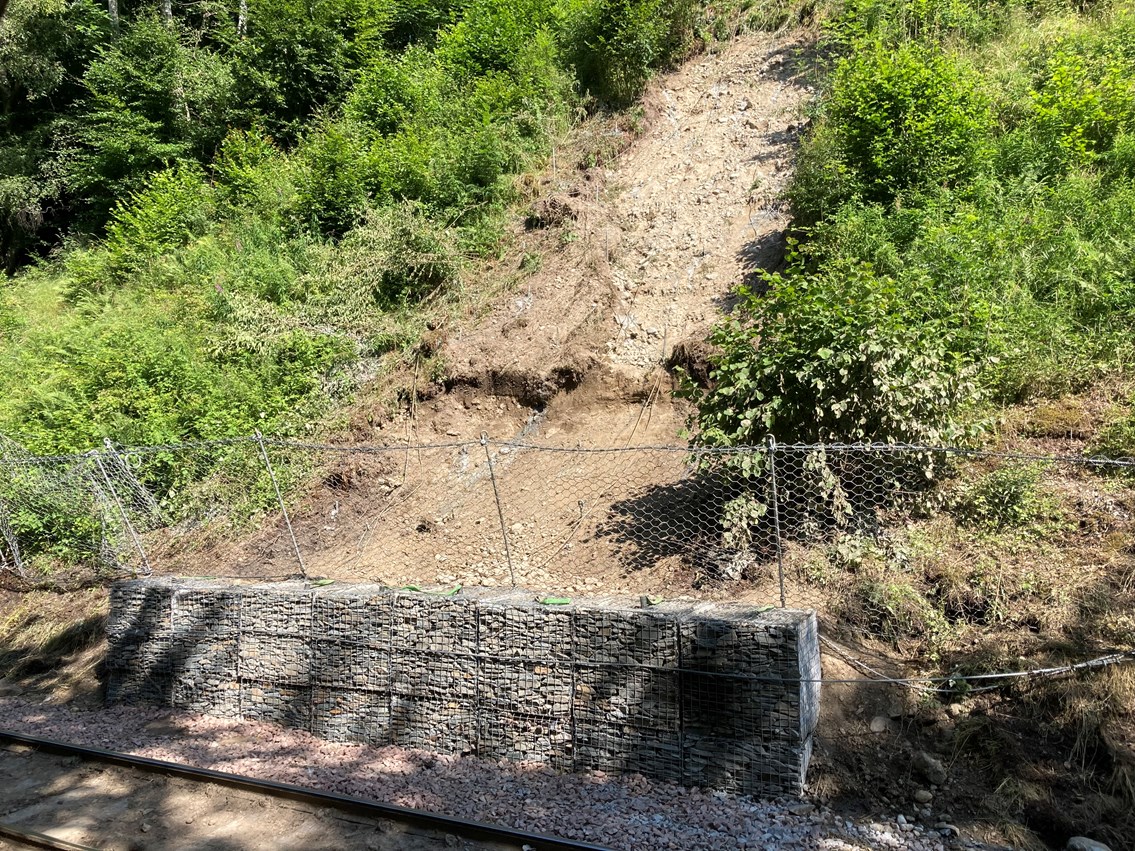Thursday 5 Aug 2021
Embankment works bring stability to Highland Mainline
- Region & Route:
- Scotland’s Railway: Scotland
Network Rail has completed 2 weeks of work to stabilise and protect an embankment at Killiecrankie on the Highland Main Line following a landslip in July.
More than 50 tonnes of mud and vegetation had to be removed from the track and the slope after heavy rainfall on July 11 caused water to run onto the railway from third-party land triggering the landslip.
The line was closed while specialist engineers assessed the damage and the track was then cleared and re-opened at a restricted speed on July 12.
In order to protect the area from further damage, a wall of gabion baskets has been positioned at the bottom of the slope to help stabilise it. A tensioned catchfence was installed on the slope prior to the landslip and helped prevent a larger volume of material reaching the track was also repaired and reinstated.
Erosion netting was also laid to prevent any further washout and encourage vegetation regrowth, binding the top layer of soil together to prevent deterioration on the slope surface.
With work now completed, the speed restriction has been lifted allowing services to return to normal on the Highland Mainline between Pitlochry and Blair Atholl.
The team are continuing to liaise with stakeholders to ensure that the third-party drainage issue, which caused this landslide, is resolved.
Thomas Podger, Network Rail’s project manager for the works, said: “We have an extensive programme of proactive works to prevent these types of incidents from occurring, but increasingly, extreme weather events are having a significant impact on our railway.
“When this incident happened, our team responded quickly to initially ensure the safety of the cutting and get the railway cleared and re-opened to minimise disruption for passengers. We then followed up with additional works to stabilise and protect the cutting and improve the drainage in the area to reduce the risk from heavy rainfall in the future.”
Network Rail is investing heavily in Scotland’s Railway to improve the condition of earthworks and drainage systems.
Between 2014 and 2019, over £120m was invested in earthworks, drainage and bridge strengthening projects around Scotland. In the five years between 2019 and 2024 a further £149m will be spent.
These investments will include over £30m to improve the infrastructure’s resistance to extreme rainfall, £13m targeted at known flood sites and £25m invested in vegetation management programmes.
Contact information
Passengers / community members
Network Rail national helpline
03457 11 41 41
Latest travel advice
Please visit National Rail Enquiries
Journalists
Network Rail press office - Owen Campbell
NR Press Office 0141 555 4108 / 07515 617073
Owen.Campbell1@networkrail.co.uk
About Network Rail
We own, operate and develop Britain's railway infrastructure; that's 20,000 miles of track, 30,000 bridges, tunnels and viaducts and the thousands of signals, level crossings and stations. We run 20 of the UK's largest stations while all the others, over 2,500, are run by the country's train operating companies.
Usually, there are almost five million journeys made in the UK and over 600 freight trains run on the network. People depend on Britain's railway for their daily commute, to visit friends and loved ones and to get them home safe every day. Our role is to deliver a safe and reliable railway, so we carefully manage and deliver thousands of projects every year that form part of the multi-billion pound Railway Upgrade Plan, to grow and expand the nation's railway network to respond to the tremendous growth and demand the railway has experienced - a doubling of passenger journeys over the past 20 years.
Follow us on Twitter: @networkrail
Visit our online newsroom: www.networkrailmediacentre.co.uk

